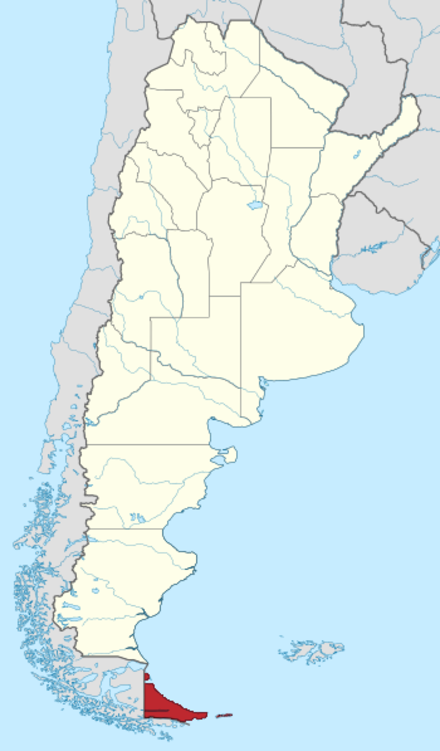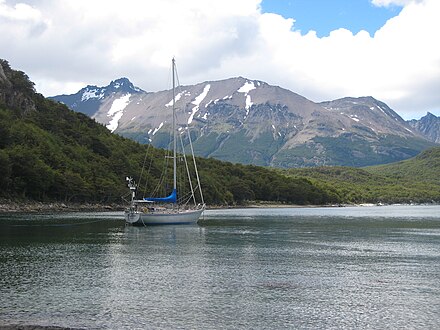Tierra del Fuego
For other places with the same name, see Tierra del Fuego (disambiguation).
 Tierra del Fuego is a 73,000 km² large archipelago off the south of South America, divided between Argentina and Chile by the 1881 Treaty. This article covers the argentinean (eastern) portion (aka the Province of Tierra del Fuego). The western and southern part (including Cape Horn) belongs to Chile and is covered in the article Tierra del Fuego (Chile).
Tierra del Fuego is a 73,000 km² large archipelago off the south of South America, divided between Argentina and Chile by the 1881 Treaty. This article covers the argentinean (eastern) portion (aka the Province of Tierra del Fuego). The western and southern part (including Cape Horn) belongs to Chile and is covered in the article Tierra del Fuego (Chile).
Islands
-
Isla Grande de Tierra del Fuego — the main island, with an area around 48,000 km² whereby 38.6% belong to Argentina, is commonly referred to as Tierra del Fuego or as Isla Grande. The argentine fraction is shaped like a triangle with its base at the Beagle Channel. Over 90% of the island's population live in Ushuaia and Rio Grande, both on the eastern, Argentine side.
-
Isla de los Estados — 530 km², unpopulated, 30 km off the south-eastern edge of Isla Grande.
-
Small, unpopulated islands facing Ushuaia — Les Eclaireurs, Bridges, Hache (H) and others
-
Other islands on the Beagle Channel — Gable Island (20 km²) and other small islets, all uninhabited
Cities
- Río Grande — the economic capital of Argentine Tierra del Fuego, its industries include oil, electronics and cattle breeding. It's traditional estancias and trout fishing are touristically notable.
- Ushuaia — tourist centre of Tierra del Fuego, and base for most excursions, treks and trips to Antarctica. Arguably the most southerly city in the world
Other destinations
- Tierra del Fuego National Park — a rugged, mountainous national park with great views of Lapataia Bay.
Understand

History
Tierra del Fuego (Spanish: Land of Fire) got its name from Ferdinand Magellan who, on passing the archipelago in 1520, spotted a number of fires burning along the coastline. These fires may have been made by the archipelago's aboriginal inhabitants: the Ona, Alakaluf and Yahgan (commonly called Yámana). Four aboriginals were taken from Tierra del Fuego in 1830 by Robert Fitzroy, and were sailed to Britain to meet the King. The three survivors later returned to Tierra del Fuego on the Beagle, with Charles Darwin, who believed the native Fuegans to be "the missing link". The arrival of missionaries, introduction of sheep farming and the discovery of gold in the 1880s led to European, Argentine, and Chilean immigrants, which gradually killed off the native Fuegans.
An excellent book on the history of the Yámana and their demise is The Uttermost Part of the Earth by E. Lucas Bridges, the son of one of the early missionaries. His father, Thomas Bridges, documented what he could of the Yámana language and found that it had a larger vocabulary than the English language.
Today, the economy is based on petroleum, tourism, textiles, electronics and, to a decreasing degree, sheep-farming.
Climate
The western parts of the archipelago form the southernmost tip of the Andes range. The eastern parts are an extension of the Patagonian plateau. Based in the south of Patagonia, the climate is cold but warmer than many assume; in winter, the average temperature is -2°C (28°F). In summer, it can climb to 30°C (86°F), although in reality it rarely rises far beyond 10°C (50°F). There are frequent high winds and much rainfall, especially in the coastal areas.
Get in
By plane
There are regular Aerolineas Argentinas flights from Buenos Aires to Ushuaia (IATA: USH) and Rio Grande. Air services also link major settlements to Punta Arenas in Chile.
By bus
Buses from all over Argentina enter Tierra del Fuego via Rio Gallegos. Note that buses running from Rio Gallegos to Ushuaia all pass through Chile, and thus trips include two border crossings.
By car
Argentine National Route 3 connects Buenos Aires to the Chilean border near Tierra del Fuego. There is no road from main cities of Chile to Tierra del Fuego, so the Argentine road must be used. To reach Tierra del Fuego by car the ferry service must be used.
By ferry
Ferry service on the Melinka regularly links Porvenir and Punta Arenas, and naval vessels supply Ushuaia and Isla Navarino, Chile.
There is also a ferry at the narrowest part of the Strait of Magellan that connects Tierra del Fuego to mainland Chile at Primera Angostura (between Punta Delgada and Cerro Sombrero), with many departures from 8:30AM (mainland) to 11:00PM (island) every day. The crossing takes approximately 20 minutes.
Get around
Roads are poor in Tierra del Fuego, and apart from the tourist tour train, there are no railways. There is little public transport. However, tours and transport can be booked through the Tourist Office (on San Martin, Ushuaia) or through many of the hostels.
See
- Estancia Haberton — open only in the summer months, Estancia Haberton is a worthwhile trip for those interested in the Bridges family and their role in local history
- Museo Marítimo — located in Ushuaia's old prison, this excellent museum displays a collection of the history of Tierra del Fuego
Do
- Catamaran trips — catamaran trips will take you around the Beagle Channel and give you nice views of the mountains, cormorants, sea lions and penguins
- Cerro Castor — this centre for winter sports offers skiing and snowboarding. Nearby, you can also ride snowmobiles or husky sleighs during the winter
- Fin del Mundo Train — a steam train running from Ushuaia to the national park
- Hike the Glacier Martial — provided that you wear comfortable shoes and have the patience, a hike up the Glacier Martial will provide a very beautiful view of Ushuaia and the Beagle Channel
- Hike around Lakes Escondido and Fagnano — beautiful spots to walk, relax, fish, or ride a horse
- Kayak the Beagle Channel — Kayaks can be hired near Ushuaia's Aeroparque, on the promontory
- See king penguins — at Parque Pingüino Rey, on the eastern shore of the Bahia Inutile
- Take a cruise — several cruises operate from Ushuaia, taking in the Beagle Channel and some islands, such as Los Lobos Island
- Take a trip to Cabo San Pablo, Ojo del Albino or Laguna Esmeralda — these sites offer more stunning and rugged scenery
- Tierra del Fuego National Park — this national park provide some nice day hikes on well-marked trails
Eat
A regional specialty is king crab, called centolla in Spanish, and seafood is usually excellent. Otherwise, local cuisine follows the general Chilean and Argentine traditions. Fruit and vegetables have to be transported from thousands of miles away and, as such, are rarely tasty and rather expensive.
Drink
Ushuaia has several bars and one nightclub.
Stay safe
Crime rates in Tierra del Fuego are very low. If hiking or trekking, it is important to take warm, waterproof gear.
Go next
Flights can be booked from the Aerolineas office in Ushuaia. Buses to Buenos Aires and other destinations (apart from Puerto Natales) all stop at Rio Gallegos. It can be cheaper to just buy a ticket to Rio Gallegos and purchase an onward ticket from there.
Most Antarctic cruises either start in Tierra del Fuego, or go through it, so Antarctica is another destination accessible from Tierra del Fuego.
Tierra del Fuego
Timezone:MultipleCoordinates:-54.36, -67.64